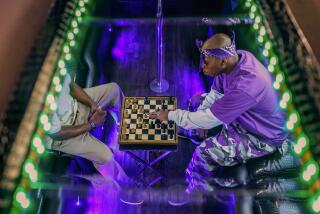Kasparov, Computers Move Chess Off Square 1 : * Competition: The popularity of the ancient game is again on the upswing in the U.S. Its national federation now has 54,000 paying members.
- Share via
NEW WINDSOR, N.Y. — Go through the storefront office, down a flight of stairs and make the second right after the supply room. There it is: the U.S. Chess Hall of Fame.
It’s a far cry from Cooperstown. Cardboard plaques honoring past grandmasters like Paul Morphy don’t draw adoring fans the way monuments to sluggers like Joe DiMaggio do at baseball’s more celebrated exhibition.
And a Russian book of opening chess moves, signed “Bobby Fischer, New York, May 1959, $1.00, Earth, U.S.A.” tends to underline an unfair American stereotype: Chess is an esoteric game for nerds.
But the image of skinny guys with horn-rimmed glasses hunkering over chessboards is becoming a thing of the past, say officials of the U.S. Chess Federation, home to the modest hall of fame and governing body for chess in this country.
“Chess has taken time to take hold in North America, so the growth is going to take longer, but I do see it starting to happen,” said the federation’s associate director, Jim Meyer.
Federation officials say home computer programs and scholastic programs are becoming more prevalent in the United States. Also, the last world chess championship match between Soviets Garry Kasparov and Anatoly Karpov mustered more attention stateside than any match since young Bobby Fischer beat world champion Boris Spassky in 1972.
Meyer said purse money for tournaments has grown even faster than membership in the federation.
While most competitions offer little in the way of prize money, top-drawer chess tournaments like the U.S. Open offer a first-place prize of $5,000. Earlier this year, Kasparov walked away with $1.7 million after beating Karpov--a far cry from the little more than $150,000 Fischer won after defeating Spassky in 1972.
“The big prizes get the people coming out of the woodwork,” Meyer said.
But would-be chess professionals be warned--it’s estimated that the number of players nationwide who make their living purely from chess couldn’t fill out a row of pawns.
With more than 54,000 paying members, the Chess Federation’s main role is to be a sort of matchmaker for chess players. A player can join, play a federation-sponsored match and receive a rating that will stand until the next match. The federation rates about 400,000 games a year.
“We have a recession going on. We still have people contacting us every day saying, ‘I’d like to find out how I can find people to play more often,’ ” said the federation’s former national marketing director, Jim Jordan.
(Chess boom or no, the recession eventually did catch up with the federation, forcing some layoffs, including Jordan’s.)
The federation, a not-for-profit group affiliated with FIDE, the International Chess Federation, also offers for its members a postal chess program, Chess Life magazine and discounts on chessboards, computers, clocks and the like.
Meyer said that in the last year, more than 3,000 people have mailed their $30 membership dues to the storefront office 50 miles north of New York City.
Sales of chess sets, computer games and books are growing at 10% a year and topped $300 million in 1989, according to federation figures.
Certainly, the biggest recent shot in the arm to the 1,300-year-old game was the Karpov-Kasparov match in New York City and Lyon, France, which ended in January. Kasparov won not only the match to retain his title but also the recognition of many Americans who wouldn’t be able to tell the difference between chess notation and a bingo card.
Newspapers and magazines gave wide publicity to the flamboyant 27-year-old Armenian.
“He’s helping dispel the image that only nerds play chess. I mean, Kasparov is not a nerd,” Jordan said.
Kasparov has become the most visible advocate of chess in the world. He plays chess with 30 students at once, fairly running from board to board. He plays against “Deep Thought,” the most advanced chess computer to date, and wins. He plays phone chess on TV with David Letterman.
“He wants chess to be recognized as the art that it is,” Jordan said.
Federation officials hope Kasparov will strip chess of the esoteric mystique it has in this country.
Chess has had a . . . well, checkered history in the United States. In the 1850s, American champion Paul Morphy could beat opponents literally blindfolded. But the world champion, Howard Staunton, wouldn’t even play Morphy when he made a trip to England in 1851.
In this century, the United States produced a number of chess greats now enshrined in the federation’s Hall of Fame, but no one to take the world title from world powerhouses, notably the Soviet Union.
That is, until Bobby Fischer.
Fischer became a lightning rod for media attention when he beat the Soviets’ Boris Spassky for the world championship at the age of 15. The eccentric champion was on the covers of scores of magazines, including Sports Illustrated and Life. At the height of Cold War tensions, the young American who beat the Soviets at their own game caught the country’s imagination.
The federation saw its membership double in a year. But the swelling of ranks was short-lived. Fischer dropped out of the chess scene by not defending his title in 1975. And as Fischer went, so did about half of the federation’s members. The boom went bust.
But things look different to chess watchers this time.
“This is our second boom. But it’s not like the one in 1972,” said John Donaldson, associate editor of Inside Chess magazine and a member of the USCF policy review board.
Donaldson and others say Kasparov is in for the long haul to strengthen the chess program.
More to Read
Sign up for Essential California
The most important California stories and recommendations in your inbox every morning.
You may occasionally receive promotional content from the Los Angeles Times.










